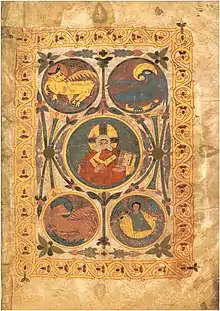León Bible of 960
The León Bible of 960 or Codex Biblicus Legionensis is a Bible manuscript copied and illuminated in 960 at the monastery of Valeránica in Tordómar. It is now held in the library of the Basílica de San Isidoro, León - why it moved there is unknown, though the monastery in which it was produced disappeared at the end of the 10th century and so it could have been given to the Basilica during the 11th century by Ferdinand I of Leon and his wife Sancha, the main patrons of the basilica.[1]
_001.jpg.webp)
Its colophon shows it was completed in the monastery of Valeránica on 19 June 960, copied and illuminated by a copyist named Sanctus and his master Florentinus, though it is difficult to distinguish between the two men's work. They are shown together toasting its completion beneath a large omega (f.514r),[2] which may have been influenced by Islamic scenes of the heavenly banquet in Islamic art.[3]
Its text is in two columns of Visigothic minuscule, usually used in Spanish manuscripts between the 8th and 12th centuries. It contains a high number of glosses in Latin and Arabic. It begins with a large full-page image showing Christ and the four symbols of the evangelists in medallions. This is followed by ten pages of tables showing Christ's descent from Adam and Eve. The Old Testament is decorated with 80 images within the columns, illustrating the passages immediately above them. The New Testament is less decorated, with ten pages of canon tables and small miniatures of saint Paul at the start of the epistles. The illuminations' style is close to that of Beatus manuscripts of the same era and of Spanish High Medieval illuminated manuscripts.[2]
Gallery
 Frontispiece - Christ and evangelists
Frontispiece - Christ and evangelists Incipit of the Book of Genesis
Incipit of the Book of Genesis David before the Ark of the Covenant
David before the Ark of the Covenant
Sources of its iconography
Its iconography has various sources. Its arrangement of Old Testament illustrations seems to show it was copied from a lost Visigothic bible, which had itself been copied from older illuminated manuscripts.[4] A more recent model could have served as an intermediary stage - the copyist Florentinus produced a (now lost) bible in the same monastery in 943, which also acted as the model for a bible copied at San Isidoro around 1162. Florentinus also produced the Commentary on Job of 945, which might have been another inspiration for the illuminations in the 960 Bible.[2][3]
Palmettes and half-leaves also show Islamic influence whilst the frontispiece of Christ and the evangelists' symbols is influenced by Carolingian models, particularly in its colour scheme.[5] A third influence may be a Jewish manuscript drawing on the wall-paintings in the Dura-Europos synagogue, such as the sacrifice of Isaac or Aaron in front of the tabernacle,[6] though this hypothesis is questioned.[7]
Bibliography
- (in French) John Williams, Manuscrits espagnols du Haut Moyen Âge, Chêne, 1977, 119 p. (ISBN 2851081470), p. 35 et 55-61
References
- (in Spanish) Codex biblicus legionensis : veinte estudios, Editorial Isidoriana, 1999, 340 p. (ISBN 978-8474970081)
- The Art of Medieval Spain: A. D. 500 - 1200, Metropolitan Museum of Art, 1993, 358 p. (ISBN 9780810964334), p. 235-236
- Williams, p.61
- Williams, p.57
- Williams, p.55
- Williams, p.60
- Joseph Gutmann, "The Dura Europos Synagogue Paintings and Their Influence on Later Christian and Jewish Art", Artibus et Historiae, vol. 9, no 17, 1988, p. 25-29 (JSTOR 1483314)